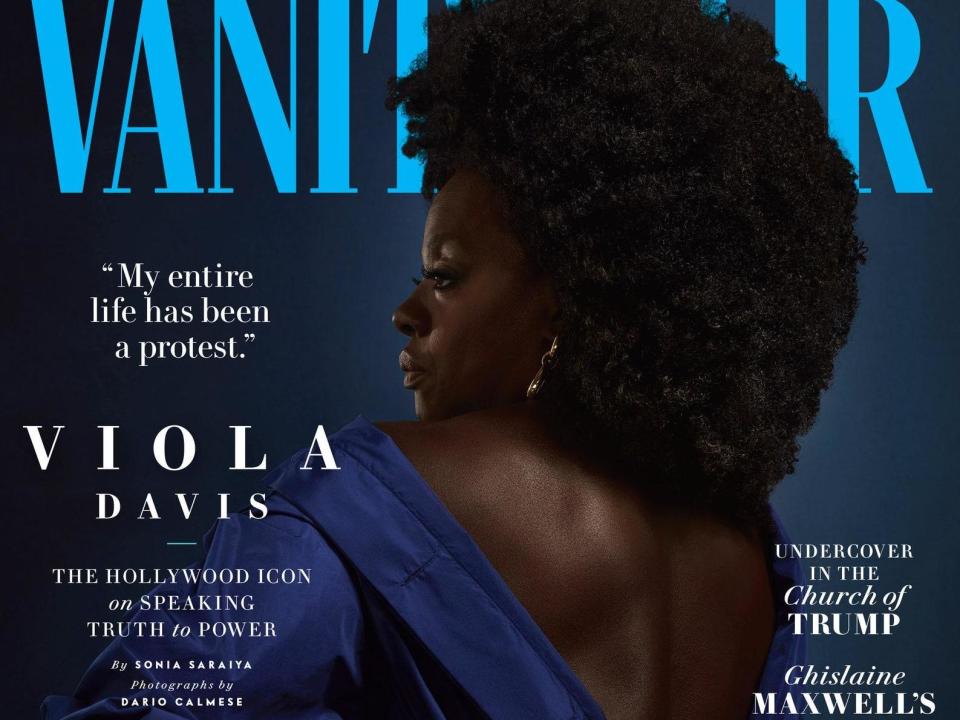‘For me, this cover is my protest’: Vanity Fair publishes first ever cover shot by black photographer

Vanity Fair has published its first front cover shot by a black photographer in its known history, the magazine’s editor announced on Tuesday.
The July to August issue features the image of actress Viola Davis, taken by photographer Dario Calmese.
“To the best of our knowledge, it is the first Vanity Fair cover made by a black photographer,” Radhika Jones wrote in her July to August editor’s letter.
Mr Calmese told The New York Times he intended to reimagine Davis as “the black Athena, representing survival and justice, or the black Madonna representing the transformation of one’s internal darkness into light.”
“Black women have held this country together since its inception,” he said. And yet, he told the newspaper, “they’re rendered invisible.”
Mr Calmese, 38, said that he began taking portraits of black people around 2012 while enrolled at the School of Visual Arts in Manhattan.
He explained that he is a multifaceted creative without one singular mode of expression, and alongside his photography also writes, curates art shows, directs fashion shows, and hosts the “Institute of Black Imagination” podcast.
Last year he began shooting for Vanity Fair with Billy Porter as his first subject before being asked to photograph Davis for his first major magazine cover in June this year.
The photograph on the cover is a recreation of an image he said he had long held in his reference folder and had recently re-discovered: “The Scourged Back,” an 1863 portrait of an enslaved man with severe whipping scars.
“This image reclaims that narrative, transmuting the white gaze on black suffering into the black gaze of grace, elegance, and beauty,” he said of the image according to Vanity Fair.
Viola Davis for V.F. July/August 2020. Photographs by Dario Calmese. The cover marks the first V.F. cover shot by a Black photographer. https://t.co/izJBKTFrt7 pic.twitter.com/SeUdZkQwoO
— VANITY FAIR (@VanityFair)
While he did not initially intend for the darker lit recreation to be used for the cover in light of its scheduling for the summer issue, both Mr Calmese and Ms Jones decided it was too powerful to ignore.
“When I saw the work and saw the picture, it just felt right,” Ms Jones said.
Davis, best known for her role in Fences, for which she won an Academy Award, spoke out against the lack of representation of black women on the magazine’s front cover during her interview.
“They’ve had a problem in the past with putting black women on the covers,” she told Vanity Fair.
“There’s a real absence of dark-skinned black women. When you couple that with what’s going on in our culture, and how they treat black women, you have a double whammy. You are putting us in a complete cloak of invisibility.”
Ms Jones admitted in her editor’s letter that the magazine had only published 17 solo covers featuring black people between 1983 and 2017.
“Davis is right, about black women—and men (and, for that matter, other people of colour as well as LGBTQ+ subjects). For most of the magazine’s history, a black artist, athlete, or politician appearing on a regular monthly issue of Vanity Fair was a rare occurrence,” she said.
“I was determined to change it when I took over as editor in chief—not just as a corrective measure but because it is my job, and the magazine’s job, to centre people who are visionaries, who are moving the culture forward,” she added.
The milestone comes against a backdrop of social and structural upheaval across the country in the wake of the death of George Floyd and subsequent national civil unrest against racial discrimination and systemic racism.
Discussing the protests, which erupted in all 50 states after Floyd died on 25 May at the hands of a white police officer in Minneapolis, and speaking of her own participation in a neighbourhood demonstration, Davis said: "I feel like my entire life has been a protest.”
“My production company is my protest. Me not wearing a wig at the Oscars in 2012 was my protest. It is a part of my voice, just like introducing myself to you and saying, ‘Hello, my name is Viola Davis',” she told the magazine.
Mr Calmese also spoke of his own desire to stage a protest through his photography and the cover of Davis by re-writing a narrative “not only around slavery, but also the white gaze on black bodies”.
“For me, this cover is my protest,” he said. “But not a protest in ‘Look at how bad you’ve been to me, and I’m angry, and I’m upset.’” Rather, it’s: “I’m going to rewrite this narrative. I’m just going to take ownership of it.”
Read more
Viola Davis cast as Michelle Obama in new TV series First Ladies
Viola Davis says The Help was ‘created in cesspool of systemic racism’
Beyoncé, Viola Davis and more sign letter against voter suppression
Why Vogue’s front cover made me feel better about my psychosis and OCD
Vogue Portugal pulls cover accused of glamourising mental illness

